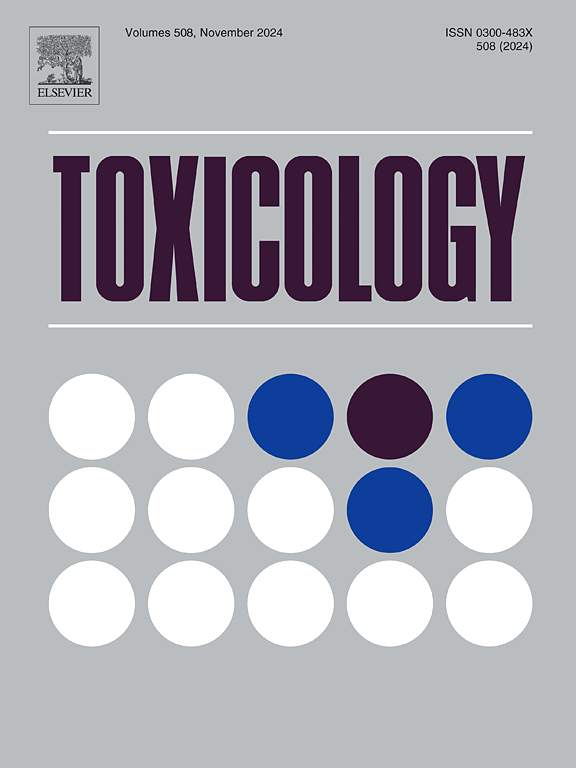多组学分析揭示BPF暴露通过破坏能量稳态导致大鼠肝脏糖脂代谢紊乱。
IF 4.8
3区 医学
Q1 PHARMACOLOGY & PHARMACY
引用次数: 0
摘要
双酚F (BPF)是双酚A (BPA)的主要替代品之一,广泛用于家居产品的制造。此外,BPF还通过环境污染和食物链威胁人类健康。然而,BPF对肝脏的毒性及其对糖脂代谢的影响尚不清楚。本研究以雄性SD大鼠为动物模型,研究BPF的肝毒性及其对糖脂代谢的影响。HE、血清及肝脏生化指标结果显示,BPF可破坏肝脏基本结构,引起肝功能障碍,导致肝脏糖代谢和脂代谢紊乱。此外,我们对100mg/kg/d BPF暴露组的肝脏进行了代谢组学和蛋白质组学分析,并与对照组进行了比较。结果表明,双酚f暴露对肝脏代谢有显著影响。结合生物学分析和对肝脏糖脂代谢相关基因和蛋白变化的验证,阐明BPF可通过AMPK和PPAR信号通路促进脂肪酸氧化,抑制脂肪酸合成,导致脂肪酸减少。此外,有研究表明BPF可通过AKT通路促进糖原合成和糖异生,从而导致糖代谢紊乱。本文章由计算机程序翻译,如有差异,请以英文原文为准。
Multi-omics analysis reveals BPF exposure causes hepatic glucose and lipid metabolism disorder in rats by disrupting energy homeostasis
Bisphenol F (BPF) is one of the main substitutes for Bisphenol A (BPA) and is widely used in the manufacture of household products. In addition, BPF threatens human health through environmental pollution and the food chain. However, the hepatotoxicity of BPF and its effects on glucose and lipid metabolism remain unclear. This study used male SD rats as an animal model to investigate the hepatotoxicity of BPF and its effects on glucose and lipid metabolism. The results of the HE staining, serum and liver biochemical indicators show that BPF can damage the basic structure of the liver, cause liver dysfunction and lead to disorders of liver glucose metabolism and lipid metabolism. Furthermore, we conducted metabolomics and proteomics analyses on the livers of the BPF exposed group at 100 mg/kg/d in comparison with the control group. The results indicated that BPF exposure had a significant effect on liver metabolism. Combined with biological analysis and the validation of changes in genes and proteins related to glucose and lipid metabolism in the liver, it was elucidated that BPF can promote fatty acid oxidation and inhibit fatty acid synthesis through the AMPK and PPAR signaling pathways, leading to a reduction in fatty acids. Furthermore, it has been demonstrated that BPF can promote glycogen synthesis and gluconeogenesis via the AKT pathway, which can result in disorders of glucose metabolism.
求助全文
通过发布文献求助,成功后即可免费获取论文全文。
去求助
来源期刊

Toxicology
医学-毒理学
CiteScore
7.80
自引率
4.40%
发文量
222
审稿时长
23 days
期刊介绍:
Toxicology is an international, peer-reviewed journal that publishes only the highest quality original scientific research and critical reviews describing hypothesis-based investigations into mechanisms of toxicity associated with exposures to xenobiotic chemicals, particularly as it relates to human health. In this respect "mechanisms" is defined on both the macro (e.g. physiological, biological, kinetic, species, sex, etc.) and molecular (genomic, transcriptomic, metabolic, etc.) scale. Emphasis is placed on findings that identify novel hazards and that can be extrapolated to exposures and mechanisms that are relevant to estimating human risk. Toxicology also publishes brief communications, personal commentaries and opinion articles, as well as concise expert reviews on contemporary topics. All research and review articles published in Toxicology are subject to rigorous peer review. Authors are asked to contact the Editor-in-Chief prior to submitting review articles or commentaries for consideration for publication in Toxicology.
 求助内容:
求助内容: 应助结果提醒方式:
应助结果提醒方式:


